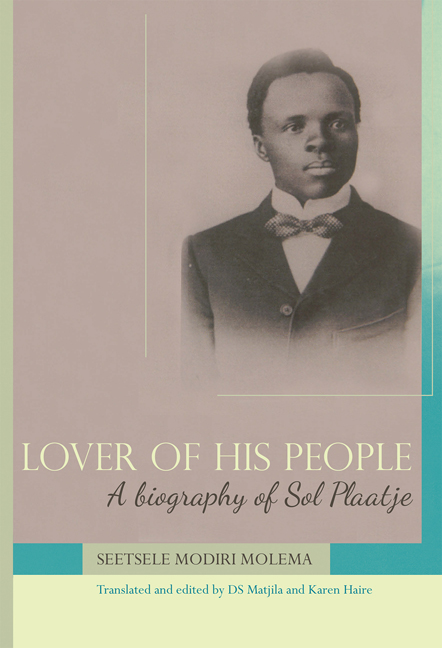Book contents
- Frontmatter
- Contents
- Acknowledgements
- Preface
- Foreword: Seetsele ModiriMolema: A star
- Chapter One First Encounter and Acquaintance
- Chapter Two Early Days and Youth
- Chapter Three An Unforgettable Year: 1896
- Chapter Four Life's Challenges
- Chapter Five Plaatje, The Career Journalist
- Chapter Six Government News
- Chapter Seven Conventions and Writings
- Chapter Eight Delegations and Meetings
- Chapter Nine Last Meetings and Travels
- Chapter Ten The Last Encounter
- Chapter Eleven Plaatje in His Own Words: English Extracts
- Chapter Twelve Plaatje in His Own Words: Setswana Extracts
- Seetsele Modiri Molema of the Mahikeng Molemas
- Bibliography
Chapter Two - Early Days and Youth
Published online by Cambridge University Press: 16 March 2018
- Frontmatter
- Contents
- Acknowledgements
- Preface
- Foreword: Seetsele ModiriMolema: A star
- Chapter One First Encounter and Acquaintance
- Chapter Two Early Days and Youth
- Chapter Three An Unforgettable Year: 1896
- Chapter Four Life's Challenges
- Chapter Five Plaatje, The Career Journalist
- Chapter Six Government News
- Chapter Seven Conventions and Writings
- Chapter Eight Delegations and Meetings
- Chapter Nine Last Meetings and Travels
- Chapter Ten The Last Encounter
- Chapter Eleven Plaatje in His Own Words: English Extracts
- Chapter Twelve Plaatje in His Own Words: Setswana Extracts
- Seetsele Modiri Molema of the Mahikeng Molemas
- Bibliography
Summary
The Barolong are a tribe known in their history for splitting apart and separating to form many branches. The breaking-up began mainly because of the polygamous marriages of dikgosi, kings, and the conflicts that arose over succession. In addition, separation of the tribe occurred when the throne was being held for the children of dikgosi by their father's younger brother, rangwane, serving as regent until the heir came of age. Sometimes the regent would become powerful and refuse to step down from the chieftaincy. In that situation, the heir to the throne would grow up in exile, away from home, together with his father's followers. This is the reason why there are branches like the Barolong Boo-Modiboa, Barolong Boo-Sehuba, Barolong Boo-Seleka, Barolong Boora-Tshidi and Barolong BoMorakile of old, as well as the modern branches, the Barolong Boo-Ratlou and Barolong Boo- Rapulana. Among all the Barolong, Barolong Boo-Modiboa were the most senior family, that is, the legitimate royal house, but they were ousted by their younger siblings between the 1500s and 1600s.
Plaatje was a Morolong descendant of Modiboa, whose kingdom fell apart after his death. Tshesebe, the son of a lower house of Modiboa toppled the kingship and the tribe of Mongale, son of the senior house. Thus Mongale and his followers left the erstwhile royal homestead in the middle of the village of Setlagole and settled in Molemane to the east, near Mahikeng, a distance of about sixty miles from Setlagole. There, in Molemane, Mongale begat Sehuba, Sehuba begat Mokoto, Mokoto begat Dira and Dira begat Selogilwe, in the years between 1600 and 1750.
During skirmishes and scuffles, the Boo-Modiboa moved to Matlosane (Klerksdorp), a distance of 100 miles to the south, but they did not stay long. They continued their migration another 100 miles until they reached the region of Maamusa (Schweizer-Reineke). There, Selogilwe, descendant of Modiboa, begat Mogoja, Mogoja begat Sebeka, Sebeka begat Dira II, and Dira II begat Selogilwe II, in the years between 1750 and 1830. In those days, the land of Maamusa was inhabited by the Hottentots of Taaibosch.
The most accurate history of the Plaatje family and their migrations begins in the year 1830 with Selogilwe. He stayed a while in the land of Maamusa but went to Thaba Nchu with his children, Dira, Mogodi and Maseng, to flee the Matabele led by Mzilikazi.
- Type
- Chapter
- Information
- Lover of his PeopleA biography of Sol Plaatje, pp. 14 - 25Publisher: Wits University PressPrint publication year: 2013

